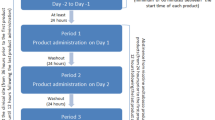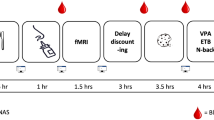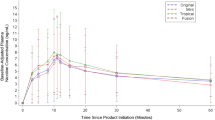Abstract
Objective:
Develop a dose–response curve for the effect of intranasal lidocaine on food intake.
Design:
Healthy obese subjects had food intake, ratings of hunger, desire to eat, craving and fullness measured at lunch after an overnight fast. Four treatments were given as nose drops (0.5–0.6 ml per nostril) 5 min before the meal in a double-blind manner with a four period crossover design including a 7-day washout between periods. The treatments were saline, 2.5, 10 and 25 mg lidocaine per nostril. The order of administration was randomly assigned to each subject. Electrocardiograms, vital signs, chemistry panels, complete blood counts (CBC) and nasal inspections were carried out before and after each dose.
Subjects:
Forty-seven subjects were screened, 34 were randomized and 20 subjects completed all four study periods in the trial. The subjects were 39±12.5 (s.d) years of age, had a weight of 91±13.0 kg, a height of 167±10.3 cm, 56% were women, 47% were African-American and 53% were Caucasian.
Measurements:
Food intake, rating of hunger, desire to eat, craving and fullness are measures of efficacy. Adverse events, electrocardiograms, vital signs, chemistry panels, nasal inspections, CBC and physical exams are measures of safety.
Results:
The mean reduction in food intake vs saline control in the 20 subjects completing all four study periods was 3.3±7% (s.d), 4.2±8.5% and 7.4±7.3% in the 2.5 mg, 10 and 25 mg per nostril groups, respectively (P=NS). Hunger and desire to eat in subjects who completed at least one study period decreased dose dependently (P<0.03, at the 25 mg per nostril dose). There were no clinically significant changes in safety measures, electrocardiograms, vital signs, chemistry panels, CBC or nasal inspections.
Conclusion:
Intranasal lidocaine reduced hunger and the desire to eat, but this did not translate into a significant reduction in food intake suggesting that intranasal lidocaine will not have value in treating obesity.
This is a preview of subscription content, access via your institution
Access options
Subscribe to this journal
Receive 12 print issues and online access
$259.00 per year
only $21.58 per issue
Buy this article
- Purchase on Springer Link
- Instant access to full article PDF
Prices may be subject to local taxes which are calculated during checkout
Similar content being viewed by others
References
Fedoroff IC, Polivy J, Herman CP . The effect of pre-exposure to food cues on the eating behavior of restrained and unrestrained eaters. Appetite 1997; 28: 33–47.
Jansen A, van den Hout M . On being led into temptation: ‘counterregulation’ of dieters after smelling a ‘preload’. Addict Behav 1991; 16: 247–253.
Rogers PJ, Hill AJ . Breakdown of dietary restraint following mere exposure to food stimuli: interrelationships between restraint, hunger, salivation, and food intake. Addict Behav 1989; 14: 387–397.
Young TM, Mathias CJ . Taste and smell disturbance with the alpha-adrenoceptor agonist midodrine. Ann Pharmacother 2004; 38: 1868–1870.
Rousseaux M, Muller P, Gahide I, Mottin Y, Romon M . Disorders of smell, taste, and food intake in a patient with a dorsomedial thalamic infarct. Stroke 1996; 27: 2328–2330.
Wilson MM, Morley JE . Invited review: aging and energy balance. J Appl Physiol 2003; 95: 1728–1736.
Schiffman SS . Taste and smell losses in normal aging and disease. Jama 1997; 278: 1357–1362.
Roessner V, Bleich S, Banaschewski T, Rothenberger A . Olfactory deficits in anorexia nervosa. Eur Arch Psychiatry Clin Neurosci 2005; 255: 6–9.
Hardman J, Limbird L . Goodman and Gilman's The Pharmacological Basis of Therapeutics. McGraw-Hill Health Professions Division: New York, 1999.
Morricone L, Bombonato M, Cattaneo AG, Enrini R, Lugari R, Zandomenighi R et al. Food-related sensory stimuli are able to promote pancreatic polypeptide elevation without evident cephalic phase insulin secretion in human obesity. Horm Metab Res 2000; 32: 240–245.
Rogers J, Raimundo AH, Misiewicz JJ . Cephalic phase of colonic pressure response to food. Gut 1993; 34: 537–543.
Sjostrom L, Garellick G, Krotkiewski M, Luyckx A . Peripheral insulin in response to the sight and smell of food. Metabolism 1980; 29: 901–909.
McEvoy G . AHFS Drug Information. Bethesda: American Health System Pharmacists, 2003.
Poothullil JM . Maintenance of weight loss using taste and smell sensations. J Womens Health 1999; 8: 109–113.
Stunkard A, Messick S . Eating Inventory Manual (The Psychological Corporation). Harcourt Brace & Company: In San Antonio, 1988.
Flint A, Raben A, Blundell JE, Astrup A . Reproducibility, power and validity of visual analogue scales in assessment of appetite sensations in single test meal studies. Int J Obes Relat Metab Disord 2000; 24: 38–48.
Bagger M, Bechgaard E . A microdialysis model to examine nasal drug delivery and olfactory absorption in rats using lidocaine hydrochloride as a model drug. Int J Pharm 2004; 269: 311–322.
Taylor A, Fountaine R, Martin C, Mancuso J, Greenway F . Reproducibility of food intake measurements and early detection of efficacy of anorectic drugs. Obes Res 2003; 11: 405-P.
Bray GA, Blackburn GL, Ferguson JM, Greenway FL, Jain AK, Mendel CM et al. Sibutramine produces dose-related weight loss. Obes Res 1999; 7: 189–198.
Koujitani T, Yasuhara K, Ikeda T, Imazawa T, Tamura T, Toyosawa K et al. Sequential observation of 2,6-dimethylaniline-induced nasal lesions in a rat two-stage nasal carcinogenesis model after initiation with N-bis(2-hydroxypropyl) nitrosamine. J Vet Med Sci 2000; 62: 751–756.
Blackburn G . Effect of degree of weight loss on health benefits. Obes Res 1995; 2 (3 Suppl): 2:211s–2:216s.
Acknowledgements
Frank Greenway, Kim Kamdar and Michael Cowley are part of a patent application on the use of intranasal lidocaine for weight loss. Frank Greenway and Jo Whitehouse held stock in Konova Inc., and Frank Greenway, Scott Cruickshank, Jo Whitehouse, Linda DeYoung, Kathleen Dumas, Barbara Floy Laidlaw, Brian Rogers and Michael Cowley received consultation fees from Konova Inc. We express appreciation to Mary Beth Burnett for preparation and submission of the manuscript.
Author information
Authors and Affiliations
Corresponding author
Rights and permissions
About this article
Cite this article
Greenway, F., Martin, C., Gupta, A. et al. Using intranasal lidocaine to reduce food intake. Int J Obes 31, 858–863 (2007). https://doi.org/10.1038/sj.ijo.0803506
Received:
Revised:
Accepted:
Published:
Issue Date:
DOI: https://doi.org/10.1038/sj.ijo.0803506



